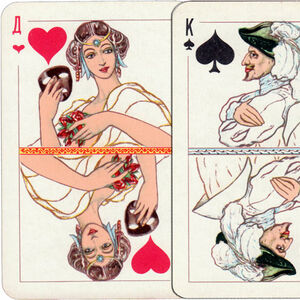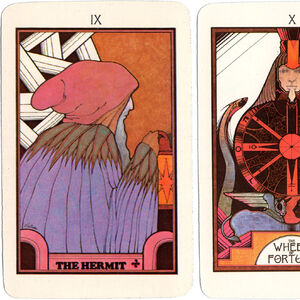Art Nouveau & Jugendstil on Playing Cards

Art Nouveau, also known as Jugendstil, was an artistic movement that emerged in Europe in the late 19th century, around the 1890s. It was inspired by a desire to break away from the academic and historicist styles that dominated art and design at the time and to create a new, modern aesthetic that reflected the changing world and the spirit of the age. Major influences on the Art Nouveau movement were the growing interest in Eastern art and design, including “exotica”, curvilinear forms and decorative motifs drawn from nature, and advances in technology. Playing cards provide many elegant and refined examples of this style, with intricate designs, bold patterns, and vibrant colours.

Nederlandsche Oliefabriek
This beautiful quartet game from Holland illustrates the strange life cycle of the peanut.

New Era No.46
“New Era No.46”, based around European fashions, was soon followed with “Circus No.47”, “Hustling Joe No.61” and “Ye Witches No.62”.

New Style ‘Jugendstil’
Playing cards showing the influence of ‘Jugendstil’ manufactured by the Soviet Playing Card Monopoly (U.S.S.R.).

Nine art-nouveau transformation playing cards
by an unknown artist

Otto Tragy Jugendstil Spielkarten
Special Jugendstil playing cards designed by Otto Tragy and first published by Altenburger Spielkartenfabrik Schneider & Co. in c.1898.

Schweizer Luxus-Jasskarte No.41
The lower and upper knaves are depicted in a vibrant and lively manner, while the enthroned kings are more ponderous. The traditional Swiss Shield court cards also have beer tankards with a barrel on the Deuce.

Shakespearean
Shakespearean Playing Cards designed by Frederick Colin Tilney, made by John Waddington Limited, 1932-3.

The Aquarian Tarot Deck
The Aquarian Tarot Deck illustrated by David Palladini, published by Morgan Press, Inc., 1970.

Venice Simplon-Orient-Express
One of a series of sumptuous Venice Simplon-Orient-Express playing cards produced by B.P. Grimaud for the VSOE gift collection. The 3/4 length court cards depict people in Oriental costumes.

World Bridge
‘World Bridge’ produced by Modiano in Trieste, Italy, since around 1950.

